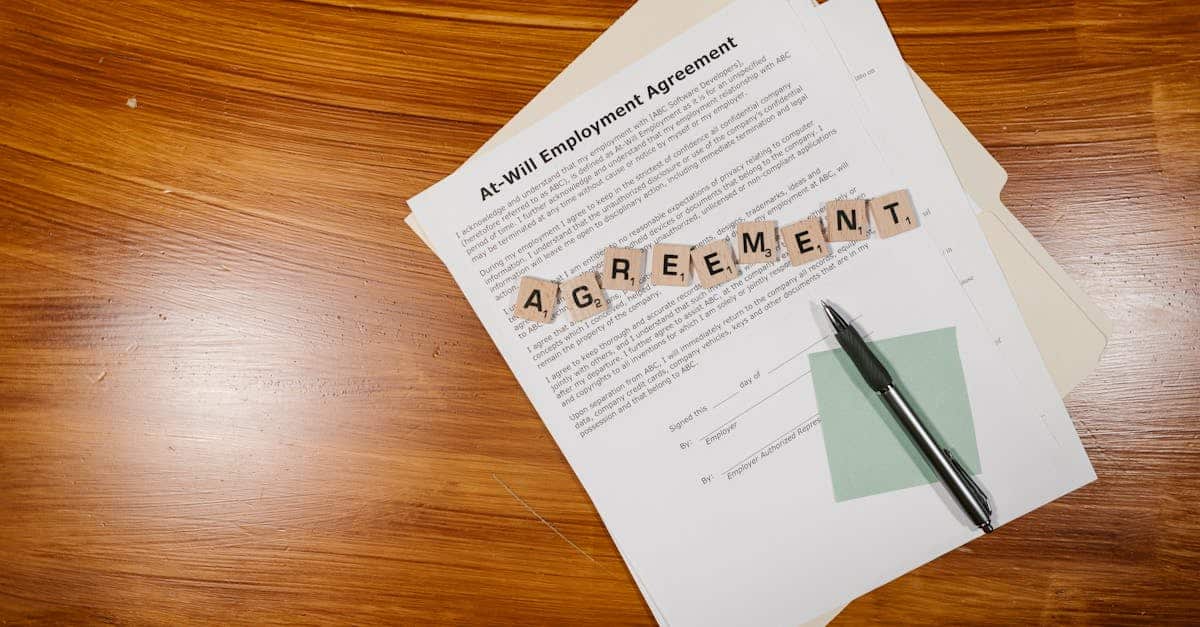
Introduction
Onboarding shouldn’t be the part of hiring that bogs you down—yet paper forms, missed IDs and scattered acknowledgements slow new hires, create compliance gaps and waste HR and legal time. With remote hiring and tighter audits becoming the norm, HR teams need faster, error‑free ways to get people ready to work without jeopardizing records or security.
This checklist lays out 12 contract and policy templates you can automate to close those gaps. From standardized offer letters and background‑check consents to I‑9 verification, role addenda, NDAs and centralized e‑sign storage, you’ll learn how to bundle documents into a smart packet, auto‑populate fields from your HRIS and enforce retention and follow‑up rules. Use these steps to streamline acceptance, ensure consistent employee agreements and stay audit‑ready—quickly.
Essential pre‑hire and offer documents to automate (offer letter, background checks, I‑9/verification)
What to automate first. Start with the documents that gate hiring: the offer letter, identity and right-to-work checks, background-screening authorizations and employment verification requests. Automating these reduces manual errors and speeds acceptance.
Core items
- Offer letter — standardized, role-specific template that pulls pay, start date and reporting manager from your HRIS. Use a reusable offer letter template such as this: https://formtify.app/set/job-offer-letter-74g61.
- Background check authorizations — consents and disclosure forms tied to the screening vendor.
- I‑9 / identity verification — capture documents and verification status. Map fields so the verifier sees required IDs and expiration dates.
- Employment verification requests — automated requests and responses; sample form: https://formtify.app/set/78-employment-verification-letter-6fexi.
Why this matters for employee agreements. Early automation ensures the later employment contract or employee contract references accurate, verified facts (start date, pay, work eligibility). This reduces rework when converting an accepted offer into a formal employment agreement.
Must‑have employment contracts and role‑specific addenda for day one
Which contracts to deliver on day one. Deliver the primary employment contract (employment agreement or employee contract) and any role-specific addenda on day one so there’s no ambiguity about terms.
Essential agreements
- Employment agreement / employment contract — the definitive terms for permanent, fixed-term or contractor relationships. Use a standard employment agreement you can populate: https://formtify.app/set/employment-agreement-mdok9.
- Appointment letters — useful for senior hires or in jurisdictions that use appointment letters: https://formtify.app/set/appointment-letter-27avk.
- Role addenda — non-compete clauses, IP assignment, equity schedules, bonus plans and on-call or shift specifics.
Types to prepare for
- Permanent (indefinite) — standard employment contract with full benefits language.
- Fixed‑term — specify end date, renewal conditions and statutory notice.
- Contractor/consultant — contractor agreement that clarifies tax status, deliverables and no entitlement to benefits.
Clauses to always include: confidentiality, non-compete agreement terms (where enforceable), termination and notice, IP assignment, compensation and benefits, probation and dispute resolution.
If you operate in multiple countries, keep a version for local law (for example, employee agreements australia) to ensure compliance with jurisdictional rules.
Policy acknowledgements and confidentiality forms to collect on the first day
Collect these on day one. Policy acknowledgements should be captured immediately to ensure employees have agreed to company standards and your records are complete.
Minimum set
- Confidentiality agreement (NDA) — a stand-alone confidentiality agreement employee form or clause in the employment contract. Use this NDA template for quick setup: https://formtify.app/set/non-disclosure-agreementemployee-b9s6h.
- Security & IT policies — acceptable use, device policy, password and MFA requirements.
- Code of conduct and workplace policies — harassment, workplace safety, conflict of interest.
- Data/health authorizations — HIPAA authorization for health-related roles: https://formtify.app/set/hipaaa-authorization-form-2fvxa.
Practical tips
- Group related acknowledgements into a single packet so signers can review and sign once rather than multiple times.
- Flag high-risk roles (finance, healthcare, R&D) to require extra acknowledgements or tighter confidentiality language.
How to combine documents into one smart packet and auto‑populate from HRIS
Create a single smart packet. Bundling the offer, contract, addenda and policy acknowledgements into one packet reduces signer friction and ensures consistent data across documents.
Step‑by‑step
-
Identify templates — choose the offer letter, employment agreement, NDAs and any role addenda you’ll include.
-
Define fields — map variables (name, title, salary, start date, manager, worksite) from your HRIS.
-
Build conditional logic — show or hide documents/clauses by employment type (permanent vs contractor), jurisdiction, or role level.
-
Preview & test — auto-populate samples (employee agreements sample) and run test hires to verify data flows correctly.
-
Publish packet — deliver via secure link or email with a single signing flow.
Benefits: fewer mistakes, faster turnaround, consistent record keeping and an improved candidate experience (ideal for employee agreements for startups where speed matters).
E‑sign, secure storage and automated retention rules for onboarding records
E‑sign best practices. Use a solution that provides signer authentication, timestamps and a complete audit trail. Ensure the e‑signature platform is legally recognized in your target jurisdictions.
Storage and retention
- Central, secure repository — store executed employee agreements and supporting documents in an encrypted HR document store linked to the employee record.
- Retention policies — automate retention schedules (e.g., personnel files retained for X years after termination) to meet employment law compliance for employers.
- Access controls — role-based access, logging and regular access reviews.
Compliance considerations
- Keep original signed employment contracts and offer letters as evidence of terms.
- Ensure background check and medical records are stored separately with limited access where required by law.
- Automate expiry alerts for documents that require renewal (work permits, identities).
Automation recipes: reminders, conditional follow‑ups, and compliance reporting
Recipes to automate common workflows. Use these simple automation patterns to reduce manual follow-up and stay audit-ready.
Reminder and follow‑up recipes
- Missing document reminder — if I‑9 or ID not uploaded within 48 hours, send automated reminder to the new hire and manager.
- Conditional escalation — if background check returns an adverse result, automatically notify HR and legal and pause onboarding steps.
- Probation check‑ins — schedule 30/60/90 day check reminders tied to the employment agreement’s probation clause.
Compliance reporting
- Audit bundle — generate a packet of signed offer, contract, verifications and acknowledgements for internal or external audits.
- Retention status report — list documents approaching retention expiry or review dates.
- Headcount and contract type report — break down permanent vs fixed-term vs contractors to monitor compliance with local laws.
Example automation flow
- Candidate accepts offer (offer letter via https://formtify.app/set/job-offer-letter-74g61) → system issues employment agreement (https://formtify.app/set/employment-agreement-mdok9) → sends NDA (https://formtify.app/set/non-disclosure-agreementemployee-b9s6h) and HIPAA (if required) → starts background check → on successful checks, auto-provision systems and create retention schedule.
Summary
Onboarding doesn’t have to be a paperwork bottleneck: by automating the 12 core templates outlined in this checklist—offer letters and background consents, I‑9 verification, day‑one employment contracts and role addenda, policy acknowledgements, e‑sign and secure storage—you create a single, testable packet that reduces errors, speeds hires and keeps records audit‑ready. Standardizing fields and conditional logic cuts manual handoffs, enforces consistent terms and protects HR and legal teams from compliance gaps; automating reminders, escalations and retention rules closes the loop after signing. Automating these templates standardizes employee agreements and frees your team to focus on higher‑value compliance and people work. Ready to streamline onboarding? Start building your smart packets at https://formtify.app.
FAQs
What is an employee agreement?
An employee agreement is a written contract that sets out the working relationship between an employer and an employee, including duties, pay, benefits and notice rules. It creates clear expectations and can include confidentiality, IP assignment and dispute resolution clauses to protect both parties.
Do I need an employee agreement?
While some jurisdictions allow verbal terms, a written employee agreement is strongly recommended because it reduces ambiguity, helps enforce rights and makes compliance with labour laws easier. It’s especially important for roles with access to sensitive data, IP or special compensation arrangements.
What should be included in an employee agreement?
Key elements are job title and duties, compensation and benefits, start date and duration (if fixed‑term), termination and notice, confidentiality/IP, restrictive covenants where enforceable, and applicable law. Including probation, dispute resolution and any role‑specific addenda keeps terms practical and enforceable.
Can an employer change an employee agreement?
An employer can change terms only in line with the contract itself or with the employee’s consent; unilateral changes may be unenforceable and can risk claims of breach or constructive dismissal. Best practice is to document amendments in writing, offer consideration where required, and consult legal counsel for sensitive or material changes.
How long is an employee agreement valid?
Validity depends on the contract type: permanent agreements remain in force until terminated, fixed‑term agreements end on the specified date, and specific clauses (such as confidentiality) often survive termination. Local employment laws may set minimum notice and statutory limits, so keep jurisdictional rules in mind.





